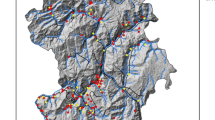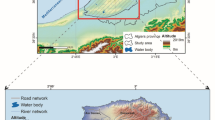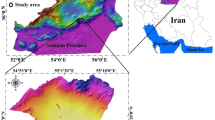Abstract
Soil erosion is a natural geomorphic process and it significantly threatens agriculture, natural resources and environment. The paper seeks to produce soil erosion susceptibility map (SESM) using weights-of-evidence (WoE) and evidential belief function (EBF) models based on geographic information system (GIS) in Pathro river basin, Jharkhand, India. In doing that, the research has taken into consideration a total number of 430 soil erosion patches in highly erosion prone areas in Pathro river basin. Within 430 cases, 300 (69.8%) are randomly selected for training purpose, while the remaining 130 (30.2%) are used for validating the model. It could be mentioned here that both the models have taken into consideration 14 soil erosion conditioning factors, which are derived from the spatial geodatabases. These soil erosion conditioning factors typically include slope, slope aspect, altitude, NDVI, curvature, distance from river, land use and land cover, soil type, rainfall erosivity, stream power index, slope length, distance from road, distance from lineament and lineament density. At the same time, use of WoE and EBF models on a GIS platform would also help one to estimate the soil erosion susceptibility value (SESV) for each pixel. At the same time, by drawing on a suitable classification technique, the paper has also prepared the soil erosion susceptibility map (SESM). Finally, the receiver operating characteristic (ROC) curves have also been prepared for both the soil erosion susceptibility models, mentioned above. The paper also calculates the area under the curve (AUC) for the verification and accuracy assessment of these two models. The result seems to suggest that the SESM, thus, prepared, drawing on both the models, has a high prediction accuracy of 89.80% for the WoE model. Similarly, the AUC for the EBF model has shown 91.80% prediction accuracy. Taken together, it could be argued that both the models have performed good prediction accuracy. In terms of the immediate value, these SESMs, produced with a high success rate and accuracy, would be of some interest and use for planners and policy makers to induct remedial measures in the erosion prone areas.








Similar content being viewed by others
References
Althuwaynee OF, Pradhan B, Lee S (2012) Application of an evidential belief function model in landslide susceptibility mapping. comput Geosci 44:120–135
Althuwaynee OF, Pradhan B, Park HJ, Lee JH (2014) A novel ensemble bivariate statistical evidential belief function with knowledge-based analytical hierarchy process and multivariate statistical logistic regression for landslide susceptibility mapping. Catena 114:21–36
Aniya M (1985) Landslide-susceptibility mapping in the amahata river basin, Japan. Ann Assoc Am Geogr 75(1):102–114
Arekhi S, Niazi Y, Kalteh AM (2012) Soil erosion and sediment yield modelling using RS and GIS techniques: a case study, Iran. Arab J Geosci 5:285–296. doi:10.1007/s12517-010-0220-4
Armas I (2012) Weights of evidence method for landslides susceptibility mapping, Prahova Subcarpathians, Romania. Nat Hazards 60:937–950
Ayalew L, Yamagishi H (2005) The application of GIS-based logistic regression for landslide susceptibility mapping in the Kakuda-Yahiko Mountains, Central Japan. J Geomorphol 65(1):15–31. doi:10.1016/j.geomorph.2004.06.010
Beasley DB, Huggins LF, Monke EJ (1980) ANSWERS: a model for watershed planning. Trans ASAE 23(4):938–944
Bonham-Carter GF (1994) Geographic information systems for geoscientists: modeling with GIS. Pergamon, Ontario, 398 p
Bonham-Carter GF, Agterberg FP, Wright DF (1988) Integration of geological datasets for gold exploration in Nova Scotia. Photogr Eng Remote Sens 54:1585–1592
Carranza EJM (2009) Controls on mineral deposit occurrence inferred from analysis of their spatial pattern and spatial association with geological features. Ore Geol Rev 35(3–4):383–340
Carranza EJM, Castro O (2006) Predicting lahar-inundation zones: case study in West Mount Pinatubo, Philippines. Nat Hazards 37:331–372
Carranza EJM, Hale M (2000) Geologically constrained probabilisticmapping of gold potential, Baguio district, Philippines. Nat Res Res 9:237–253
Carranza EJM, Hale M (2003) Evidential belief functions for data-driven geologically constrained mapping of gold potential, Baguio district, Philippines. Ore Geol Rev 22(1):117–132
Carranza EJM, Hale M, Faassen C (2008) Selection of coherent deposit-type locations and their application in data-driven mineral prospectivity mapping. Ore Geol Rev 33:536–558
Dabral PP, Baithuri N, Pandey A (2008) Soil erosion assessment in a hilly catchment of north eastern India using USLE, GIS and remote sensing. Water Resour Manag 22:1783–1798. doi:10.1007/s11269-008-9253-9
Dahal RK, Hasegawa S, Nonomura A, Yamanaka M, Dhakal S, Paudyal P (2008) Predictive modeling of rainfall-induced landslide hazard in the Lesser Himalaya of Nepal based on weights-of evidence. Geomorphology 102:496–510
Dai FC, Lee CF, Li J, Xu ZW (2001) Assessment of landslide susceptibility on the natural terrain of Lantau Island, Hong Kong. Environ Geol 43(3):381–391. doi:10.1007/s002540000163
Dempster AP (1967) Upper and lower probabilities induced by a multivalued mapping. Ann Math Stat 38:325–339
Ercanoglu M, Gokceoglu C (2002) Assessment of landslide susceptibility for a landslide-prone area (North of Yenice, NW Turkey) by fuzzy approach. Environ Geol 41:720–730. doi:10.1007/s00254-001-0454-2
Foumelis M, Lekkas E, Parcharidis I (2004) Landslide susceptibility mapping by GIS-based qualitative weighting procedure in Corinth area. Bulletin of the Geological Society of Greece XXXVI, 904–912. In: Proceedings of the 10th international congress, Thessaloniki, April 2004
Galli M, Ardizzone F, Cardinali M, Guzzetti F, Reichenbach P (2008) Comparing landslide inventory maps. Geomorphology 94(3):268–289
Gournellos T, Evelpidou N, Vassilopoulos A (2004) Developing an erosion risk map using soft computing methods (case study at Sifnos Island). Nat Hazards 31:63–83
He D (1999) Modelling of dominating factors to soil and water conservation. Fujian Forest College Trans 19(1):26–29
Hudson NW (1981) Instrumentation for studies of erosive power of rainfall. In: Proceedings of the International Symposium on Erosion and Sediment Transport Measurement. International Association for Hydrological Science: Florence, Italy, June 1981
Jozefaciuk C, Jozefaciuk A (1993) Gullies net density as a factor of water system deformation in Vistula River basin. In: Banasik K, Zbikowski A (eds) Runoff and sediment yield modelling. Agricultural University Press, Warsaw, pp 169–174
Khosrokhani M, Pradhan B (2013) Spatio-temporal assessment of soil erosion at Kuala Lumpur metropolitan city using remote sensing data and GIS. Geomat Nat Hazards Risk. doi:10.1080/19475705.2013.794164
Kim SM, Choi Y, Suh J, Oh S, Park HD, Yoon SH (2012) Estimation of soil erosion and sediment yield from mine tailing dumps using GIS: a case study at the Samgwang mine. Korea Geosyst Eng 15(1):2–9
Knisel WG (1980) CREAMS, a field scale model for chemicals, runoff, and erosion from agricultural management systems, US Department of Agriculture Research Service Report No. 26
Komac M (2006) A landslide susceptibility model using the analytical hierarchy process method and multivariate statistics in perialpine Slovenia. Geomorphology 74(1–4):17–28
Krivtsov V (2004) Investigations of indirect relationships in ecology and environmental sciences: a review and the implications for comparative theoretical ecosystem analysis. Ecol Model 174:37–54
Lal R (1994) Soil erosion research method, 2nd ed. Soil and Water Conservation Society, Ankeny, p. 352
Lal R (2001) Soil degradation by erosion. Land Degrad Dev 12:519–539
Lee S (2005) Application of logistic regression model and its validation for landslide susceptibility mapping using GIS and remote sensing data. Int J Remote Sens 26(7):1477–1491
Lee S, Min K (2001) Statistical analysis of landslide susceptibility at Yongin, Korea. Environ Geol 40(9):1095–1113
Lee S, Talib JA (2005) Probabilistic soil erosion susceptibility and factor effect analysis. Environ Geol 47(7):982–990
Li AN, Wang AS, Liang SL (2006) Eco-environmental vulnerability evaluation in mountainous region using remote sensing and GIS: a case study in the upper reaches of Mingjiang River, China. Ecol Model 192:175–187
Masoudi M, Patwardhan AM (2006) Risk assessment of water erosion for the Qareh Aghajsubbasin, Southern Iran. Stoch Environ Res Risk Assess 21:15–24
Mendicino G (1999) Sensitivity analysis on GIS procedures for the estimate of soil erosion risk. Nat Hazards 20:231–253
Mogaji KA, Lim HS, Abdullah K (2014) Regional prediction of groundwater potential mapping in a multifaceted geology terrain using GIS-based Dempster–Shafer model. Arab J Geosci doi:10.1007/s12517-014-1391-1
Mohammady M, Pourghasemi HR, Pradhan B (2012) Landslide susceptibility mapping at Golestan Province, Iran: a comparison between frequency ratio, Dempster–Shafer, and weights-of evidence models. J Asian Earth Sci 61:221–236. doi:10.1016/j.jseaes.2012.10.005
Moore ID, Burch GJ (1986) Physical basis of the length-slope factor in the Universal Soil Loss Equation. Soil Sci Soc Am J 50(5):1294–1298
Moore ID, Wilson JP (1992) Length-slope factors for the revised universal soil loss equation: simplified method of estimation. J Soil Water Conserv 47(5):423–428
Morgan RPC, Quinton JN, Rickson RJ (1990) Structure of the soil erosion prediction model for the European community. In: Proceedings of international symposium on water erosion, sedimentation and resource conservation, 9–13 October, 1990, Dehradun, India. Central Soil and Water Conservation Research and Training Institute, CSWCRTI, Deharadun, India, pp. 49–59
Moussa R, Voltz M, Andrieux P (2002) Effects of the spatial organization of agricultural management on the hydrological behaviour of a farmed catchment during flood events. Hydrol Process 16:393–412
Naqvi HR, Mallick J, Devi LM, Siddiqui MA (2013) Multi-temporal annual soil loss risk mapping employing revised universal soil loss equation (RUSLE) model in Nun Nadi Watershed, Uttrakhand (India). Arabian J Geosci 6(10):4045–4056
Nearing MA, Foster GA, Lane LJ (1989) A process-based soil erosion model for USDA water erosion prediction project. Trans ASAE 32(5):1587–1593
Nefesliog˜lu HA, Gokceoglu C, Sonmez H (2008) An assessment on the use of logistic regression and artificial neural networks with different sampling strategies for the preparation of soil erosion susceptibility maps. Eng Geol 97(3):171–191
Oh JH, Jung SG (2005) Potential soil prediction for land resource management in the Nakdong River basin. J Korea Soc Rural Plan 11(2):9–19
Oh HJ, Pradhan B (2011) Application of a neuro-fuzzy model to landslide susceptibility mapping for shallow landslides in tropical hilly area. Comput Geosci 37(9):1264–1276
Oldeman LR, Hakkeling RTA, Sombroek WG (1991) World map on the status of human induced soil degredation, with explanatory note (second revised edition). ISRIC Wageningen, UNEP, Nairobi
Onyando JO, Kisoyan P, Chemelil MC (2005) Estimation of potential soil erosion for river perkerra catchment in Kenya. Water Resour Manag 19:133–143. doi:10.1007/s11269-005-2706-5
Ozdemir A (2011b) GIS-based groundwater spring potential mapping in the Sultan Mountains (Konya, Turkey) using frequency ratio, weights of evidence and logistic regression methods and their comparison. J Hydrol 411:290–308
Papadopoulou-Vrynioti K, Bathrellos GD, Skilodimou HD, Kaviri G, Makropoulos K (2013) Karst collapse susceptibility mapping considering peak ground acceleration in a rapidly growing urban area. Eng Geol 158:77–88
Park NW (2010) Application of Dempster–Shafer theory of evidence to GIS-based landslide susceptibility analysis. Environ Earth Sci 62(2):367–376
Park NW (2011) Application of Dempster–Shafer theory of evidence to GIS-based landslide susceptibility analysis. Environ Earth Sci 62(2):367–376
Pimentel D (2006) Soil erosion: a food and environmental threat. Environ Dev Sustain 8:119–137. doi:10.1007/s10668-005-1262-8
Pourghasemi HR, Pradhan B, Gokceoglu C, Moezzi KD (2013) A comparative assessment of prediction capabilities of Dempster–Shafer and weights-of-evidence models in landslide susceptibility mapping using GIS. Geomat Nat Hazards Risk 4(2):93–118
Pradhan B, Abokharima MH, Jebur MN, Tehrany MS (2014) Land subsidence susceptibility mapping at Kinta Valley (Malaysia) using the evidential belief. Nat Hazards 73(2):1019–1042
Rahman MR, Saha SK (2009) Spatial dynamics of cropland and cropping pattern change analysis using Landsat TM and IRS P6 LISS III satellite images with GIS. Geo Spat Inf Sci 12:2
Regmi AD, Yoshida K, Dhital MR, Devkota K (2012a) Effect of rock weathering, clay mineralogy, and geological structures in the formation of large landslide, a case study from Dumre Besei landslide, Lesser Himalaya Nepal. Landslides 10:1–13. doi:10.1007/s10346-011-0311-7
Regmi AD, Yoshida K, Nagata H, Pradhan AMS, Pradhan B, Pourghasemi HR (2012b) The relationship between geology and rock weathering on the rock instability along Mugling–Narayanghat road corridor, Central Nepal Himalaya. Nat Hazards 66:501–532. doi:10.1007/s11069-012-0497-6
Regmi AD, Yoshida K, Pradhan B, Pourghasemi HR, Khumamoto T, Akgun A (2013) Application of frequency ratio, statistical index and weights-of-evidence models, and their comparison in landslide susceptibility mapping in Central Nepal Himalaya. Arab J Geosci. doi:10.1007/s12517-012-0807-z
Renard KG, Foster GR, Weesies GA, Porter JP (1991) RUSLE, revised universal soil loss equation. J Soil Water Conserv 46(1):30–33
Rooseboom A, Annandale GW (1981) Techniques applied in determining sediment loads in South African rivers. Int Assoc Hydrol Sci 133:219–224
Rozos D, Skilodimou HD, Loupasakis C, Bathrellos GD (2013) Application of the revised universal soil loss equation model on landslide prevention. An example from N. Euboea (Evia) Island, Greece. Environ Earth Sci 70(7):3255–3266
Saaty TL (1980) The analytic hierarchy process. McGraw-Hill, New York
Saha AK, Gupta RP, Arora MK (2002) GIS-based landslide hazard zonation in the Bhagirathi (Ganga) valey, Himalayas. Int J Remote Sens 23(2):357–369
Shafer GA (1976) Mathematical theory of evidence. Princeton University Press, Princeton, pp 1–24
Singh G, Babu R, Narain P, Bhusan LS, Abrol IP (1992) Soil erosion rate in India. J Soil Water Conserv 47(1):97–99
Smith SJ, Williams JR, Menzel RG, Coleman GA (1984) Prediction of sediment yield from southern plains grasslandds with the Modified universal soil loss equation. J Range Manag 37:295–297
Souchère V, Cerdan O, Dubreuil N, Le Bissonnais Y, King C (2005) Modelling the impact of agro-environmental scenarios on overland flow in a cultivated catchment (Normandy, France). Catena 61:229–240. doi:10.1016/j.catena.2005.03.010
Stocking M, Elwell HA (1973) Soil erosion hazard in Rhodesia. Rhod Agric J 70(4):93–101
Süzen ML, Doyuran V (2004) A comparison of the GIS based landslide susceptibility assessment methods: multivariate versus bivariate. Environ Geol 45(5):665–679
Terranova O, Antronico L, Coscarelli R, Iaquinta P (2009) Soil erosion risk scenarios in the Mediterrancan environment using RUSLE and GIS: an application model for Calabria (southern Italy). Geomorphology 112:228–245. doi:10.1016/j.geomorph.2009.06.009
Tien Bui D, Pradhan B, Lofman O, Revhaug I, Dick OB (2012) Spatial prediction of soil erosion hazards in HoaBinh province (Vietnam): a comparative assessment of the efficacy of evidential belief functions and fuzzy logic models. Catena 96:28–40
Tien Bui D, Tuan TA, Klempe H, Pradhan B, Revhaug I (2015) Spatial prediction models for shallow soil erosion hazards: a comparative assessment of the efficacy of support vectormachines, artificial neural networks, kernel logistic regression, and logistic model tree. Soil Eros. doi:10.1007/s10346-015-0557-6
Umar Z, Pradhan B, Ahmad A, Jebur MN, Tehrany MS (2014) Earthquake induced landslide susceptibility mapping using an integrated ensemble frequency ratio and logistic regression models in West Sumatera Province, Indonesia. Catena 118:124–135
Westen CJ, Rengers N, Soeters R (2003) Use of geomorphological information in indirect landslide susceptibility assessment. Nat Hazards 30:399–419
Williams JR, Jones CA, Dyke PT (1990) The EPIC model.United States Department of Agriculture (USDA) Technical Bulletin No. 1768
Wilson JP, Gallant JC (2000) Terrain analysis principles and applications. Wiley, New York
Wischmeier WH, Smith DD (1978) Predicting rainfall erosion losses: a guide to conservation planning. Agriculture handbook 282. USDA-ARS, USA
Wu Q, Wang M (2007) A framework for risk assessment on soil erosion by water using an integrated and systematic approach. J Hydrol 337:11–21
Xu C, Xu X, Dai F, Xiao J, Tan X, Yuan R (2012) Landslide hazard mapping using GIS and weight of evidence model in Qingshui River watershed of 2008 Wenchuan earthquake struck region. J Earth Sci 23:97–120
Yalcin A (2008) GIS-based landslide susceptibility mapping using analytical hierarchy process and bivariate statistics in Ardesen (Turkey): comparisons of results and confirmations. Catena 72:1–12. 10.1016/j.catena.2007.01.003
Yalcin A, Reis S, Aydinoglu AC, Yomralioglu T (2011) A GIS-based comparative study of frequency ratio, analytical hierarchy process, bivariate statistics and logistics regression methods for soil erosion susceptibility mapping in Trabzon, NE Turkey. Catena 85(3):274–287. doi:10.1016/j.catena.2011.01.014
Zhang Y, Degroote J, Wolter C, Sugumaran R (2009) Integration of modified universal soil loss equation (MUSLE) into a GIS framework to assess soil erosion risk. Land Degrad Dev 20:84–91
Acknowledgements
The authors would like to express cordial thanks to our respected teachers of Department of Geography, University of Gour Banga, who have always been mentally supported ourselves. Authors would also like to thanks the inhabitants of this basin because they have helped a lot during our field visit. At last, authors would like to acknowledge all of the agencies and individuals specially, Survey of India, Geological Survey of India and USGS for obtaining the maps and data required for the study.
Author information
Authors and Affiliations
Corresponding author
Rights and permissions
About this article
Cite this article
Gayen, A., Saha, S. Application of weights-of-evidence (WoE) and evidential belief function (EBF) models for the delineation of soil erosion vulnerable zones: a study on Pathro river basin, Jharkhand, India. Model. Earth Syst. Environ. 3, 1123–1139 (2017). https://doi.org/10.1007/s40808-017-0362-4
Received:
Accepted:
Published:
Issue Date:
DOI: https://doi.org/10.1007/s40808-017-0362-4




